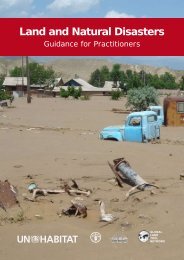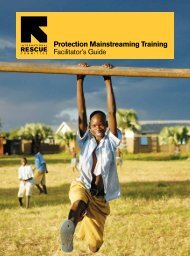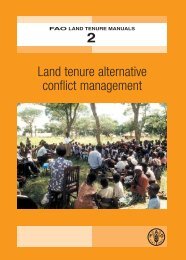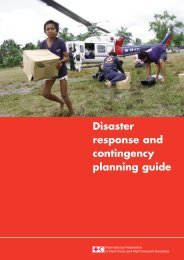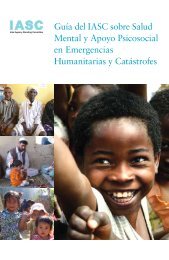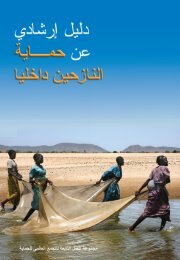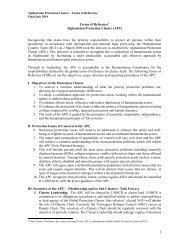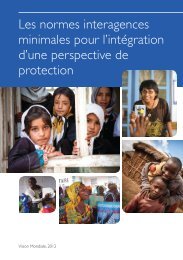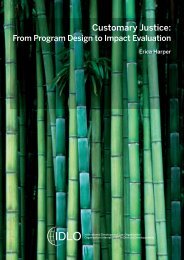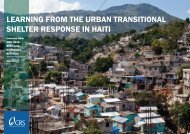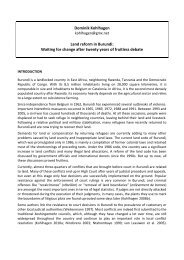Inter-Agency Real Time Evaluation of the Response to Cyclone Nargis
Inter-Agency Real Time Evaluation of the Response to Cyclone Nargis
Inter-Agency Real Time Evaluation of the Response to Cyclone Nargis
You also want an ePaper? Increase the reach of your titles
YUMPU automatically turns print PDFs into web optimized ePapers that Google loves.
team <strong>to</strong> test <strong>the</strong>se hypo<strong>the</strong>ses through a combination <strong>of</strong> document research, KIIs, workshops withNGOs and debriefings for <strong>the</strong> UN Country Team. Subsequent triangulation/validation was donethrough means <strong>of</strong> additional document research and feedback on an initial draft report.Constraints and LimitationsOne aspect <strong>the</strong> IA RTE team was asked <strong>to</strong> investigate was <strong>the</strong> impact <strong>of</strong> visa and o<strong>the</strong>r restrictionson movements <strong>of</strong> international staff, and it was anticipated that some mention <strong>of</strong> this would appearin this section as a constraint on <strong>the</strong> IA RTE team’s movements. In <strong>the</strong> event, however, this was notreally a constraint. The two international members <strong>of</strong> <strong>the</strong> IA RTE team received <strong>the</strong>ir visas andtravel permits within a matter <strong>of</strong> days and, once in Bogalay Township, <strong>the</strong> IA RTE team wasafforded <strong>the</strong> freedom <strong>to</strong> choose <strong>the</strong>ir own itinerary, and speak with communities without <strong>the</strong>presence <strong>of</strong> authorities.<strong>Inter</strong>national agency staff working in <strong>the</strong> delta confirmed that <strong>the</strong> IA RTE team’s experience in <strong>the</strong>Delta was fairly typical, demonstrating how humanitarian space has opened up. This appears only<strong>to</strong> apply <strong>to</strong> <strong>the</strong> delta region since agency staff confirmed that pre-<strong>Nargis</strong> restrictions on movementsremain in place for o<strong>the</strong>r parts <strong>of</strong> Myanmar. Indeed, some international staff who had not visited <strong>the</strong>Delta since <strong>the</strong> TCG had been established initially expressed disbelief at what <strong>the</strong> IA RTE team hadbeen able <strong>to</strong> do.While <strong>the</strong> work <strong>of</strong> <strong>the</strong> IA RTE team was facilitated by <strong>the</strong> lack <strong>of</strong> restrictions on movement, <strong>the</strong> IARTE was subject <strong>to</strong> a number <strong>of</strong> constraints and limitations, including:<strong>Time</strong> constraints – almost by definition, IA RTEs need <strong>to</strong> balance rapid feedback with a need forsufficient time <strong>to</strong> understand and analyze a complex context. As mentioned above, one such“trade-<strong>of</strong>f” in achieving such a balance was that <strong>the</strong> team only visited one <strong>of</strong> <strong>the</strong> affected<strong>to</strong>wnships. In any event, <strong>the</strong> IA RTE team was able <strong>to</strong> check on similarities and differences with<strong>the</strong> o<strong>the</strong>r affected <strong>to</strong>wnships during <strong>the</strong> two validation workshops with INGOs and nationalNGOs.Only one <strong>of</strong> <strong>the</strong> four team members had substantial prior evaluation experience. Although thiscreated some challenges, it was felt that <strong>the</strong> diversity <strong>of</strong> skills and experience in <strong>the</strong> team(management <strong>of</strong> humanitarian operations, health, education, conflict resolution, evaluation,private sec<strong>to</strong>r, etc.) helped <strong>to</strong> ensure that key issues were effectively captured, perhaps mostnotably from “non-traditional” ac<strong>to</strong>rs such as <strong>the</strong> private sec<strong>to</strong>r.The IA RTE is based upon <strong>the</strong> response in Myanmar and is mainly targeted at UN agency andINGO staff in <strong>the</strong> country. While <strong>the</strong>re are almost certainly some “transferable” lessons relevant<strong>to</strong> <strong>the</strong> global level humanitarian reform process, <strong>the</strong> results are intended <strong>to</strong> be useful first andforemost for international humanitarian agency staff in Myanmar.This IA RTE targeted international ac<strong>to</strong>rs and attempted <strong>to</strong> frame <strong>the</strong>ir contribution within anoverall response. However, because <strong>the</strong> national response <strong>to</strong> cyclone <strong>Nargis</strong> was relativelysubstantial, this is difficult <strong>to</strong> gauge with any degree <strong>of</strong> accuracy given <strong>the</strong> scope and design <strong>of</strong>this IA RTE.Apart from time constraints mentioned above, <strong>the</strong>re were two o<strong>the</strong>r obstacles <strong>to</strong> documentresearch. Firstly, although in most cases staff from international agencies provided internaldocuments requested by <strong>the</strong> IA RTE team <strong>to</strong> enhance <strong>the</strong> evidence base, <strong>the</strong>re were some35



